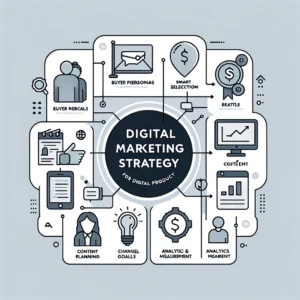In the swiftly evolving landscape of digital and software industries, the Growth Execution Model has emerged as a pivotal strategy for businesses aiming to thrive amidst rampant technological advancements and market shifts. This model, centering on dynamic adaptability and innovative approaches, is crucial for companies to not only survive but excel in an era characterized by digital disruption and intense competition.
The Digital Age: A Paradigm Shift in Business Strategy
The advent of the digital age has precipitated profound transformations in how businesses operate and compete. No longer confined to traditional methods, companies in the digital and software realms are now navigating a terrain replete with opportunities for innovation, yet fraught with challenges of rapid change and uncertainty. This new landscape demands a strategic approach that is both agile and foresighted, capable of harnessing technological advancements to drive growth and operational efficiencies.
The digital revolution has redefined the parameters of business strategy. In this era, success hinges on a company’s ability to integrate digital technologies into its core business processes, transforming not just its operational capabilities but also its market approach and customer engagement strategies. The Growth Execution Model plays a pivotal role in this transformation, offering a framework for companies to align their digital initiatives with overarching business objectives.
The Growth Execution Model: A Beacon in the Digital Storm
At its core, the Growth Execution Model in the digital and software industries is about more than just adopting new technologies; it’s a holistic approach that encompasses strategic planning, agile execution, continuous innovation, and data-driven decision-making. It’s about understanding and leveraging the nuances of digital technologies to create value, optimize operations, and foster sustainable growth.
This model compels businesses to rethink their strategies in the context of digital capabilities and market realities. It involves a relentless focus on customer needs, a commitment to innovation, and the agility to adapt swiftly to market changes. By embracing this model, companies in the digital and software sectors can position themselves not just to navigate the complexities of the digital age but to lead and define it.
In the following sections, we will delve deeper into the various components of the Growth Execution Model, exploring how companies can leverage this approach to achieve competitive advantage and sustainable growth in the digital and software industries.
The Agile Digital Strategy: Key to Thriving in the Digital Age

In the realm of digital and software industries, the concept of an agile digital strategy is not just a buzzword; it’s a fundamental requirement for survival and success. The rapid evolution of technology, the emergence of new market trends, and the constant threat of disruption necessitate a strategy that is flexible, responsive, and forward-looking.
Agility: The New Competitive Advantage
The digital age has ushered in an era of unprecedented change. In this landscape, agility has become a critical competitive advantage. According to McKinsey, companies that have embraced agility in their digital strategies are reaping significant benefits, including first-mover advantages and superior economic performance. These companies demonstrate an ability to quickly adapt to market changes, leveraging digital platforms for innovation and capitalizing on emerging opportunities.
Agility in digital strategy is not just about speed; it’s about the capacity to make swift, informed decisions based on real-time data and insights. It involves a continuous cycle of testing, learning, and iterating, allowing businesses to evolve their strategies in response to market dynamics and customer feedback.
Building a Responsive and Dynamic Digital Strategy
The process of building an agile digital strategy begins with a thorough understanding of the digital landscape and its impact on business models. McKinsey’s Global Survey highlights that despite the disruptions caused by digital technologies, many companies are struggling to make significant progress in digitalizing their business models. To overcome this, businesses must focus on developing a digital strategy that is not only responsive to external changes but also aligned with their core competencies and business objectives.
Key components of a responsive digital strategy include:
- Continuous Market Analysis: Keeping a pulse on market trends, competitor moves, and technological advancements to identify opportunities and threats.
- Flexible Business Models: Adapting business models to leverage digital technologies and meet changing customer expectations.
- Data-Driven Decision Making: Utilizing data analytics to inform strategic decisions and optimize operations.
- Innovative Culture: Fostering a culture of innovation that encourages experimentation and embraces risk-taking.
Executing with Precision and Adaptability
Execution is where strategy meets reality. For a digital strategy to be effective, it must be executed with precision and adaptability. This means having the right processes, technologies, and talent in place to implement the strategy effectively. It also involves creating an organizational structure that supports rapid execution and encourages collaboration across departments.
Businesses must be adept at adjusting their strategies in real-time, responding to market feedback, and iterating on their approach. This agility enables companies to capture first-mover advantages and establish themselves as leaders in the digital space.
Investing in Digital Ecosystems and Innovative Products
In today’s digital and software industries, investment in digital ecosystems and innovative products is not just an option; it’s an imperative for driving growth and staying competitive. These ecosystems provide a fertile ground for innovation, collaboration, and customer engagement, offering businesses unique opportunities to redefine their value propositions.
Harnessing the Power of Digital Ecosystems
Digital ecosystems, characterized by interconnected technologies, businesses, and customers, offer unprecedented opportunities for growth. As per McKinsey, companies that leverage these ecosystems for new digital products and business models tend to outperform their peers significantly. The integration of digital technologies like IoT and AI has enabled businesses to create platforms where data, insights, and services can be exchanged seamlessly, leading to new forms of value creation.
These ecosystems blur traditional industry boundaries, allowing companies to extend their reach and tap into new customer segments. By participating in or creating these ecosystems, businesses can access a wider range of resources, insights, and capabilities, fostering innovation and driving operational efficiencies.
Innovating with New Digital Products
The shift towards digital ecosystems has also prompted a rethinking of product development strategies. Top-performing companies, as indicated by McKinsey’s survey, are focusing on creating brand-new digital offerings rather than merely adjusting existing products. This involves leveraging digital technologies to develop products that are not only innovative but also aligned with the evolving needs of customers.
Innovation in digital products often requires a deep understanding of customer needs, market trends, and technological capabilities. It’s about anticipating future demands and delivering solutions that are not only technologically advanced but also user-friendly and relevant.
Transforming Business Models for Digital Success
The innovation of business models is another critical aspect of leveraging digital ecosystems. Traditional business models are rapidly becoming obsolete in the face of digital transformation. Successful companies are those that recognize this shift and adapt their models accordingly.
This may involve transitioning from a product-centric approach to a service-oriented model, where the focus is on delivering ongoing value to customers through digital services. It could also mean adopting a platform-based model, where the business acts as an orchestrator of a broader ecosystem, facilitating interactions and transactions among various stakeholders.
Utilizing M&A to Build Digital Capabilities and Businesses
Mergers and Acquisitions (M&A) have become a strategic lever for companies in the digital and software sectors to accelerate their growth and build critical digital capabilities. In an era where technological prowess is a key differentiator, M&A offers a fast track to acquiring the necessary skills, technologies, and market presence.
Strategic M&A as a Growth Accelerator
According to McKinsey, top-performing companies are using M&A not just as a tool for expansion but as a strategic instrument to enhance their digital capabilities. These companies are investing more in acquiring new digital businesses and capabilities, differentiating themselves from their peers who tend to focus on non-digital ventures. This strategic use of M&A allows these companies to quickly adapt to digital changes and maintain a competitive edge.
The Right Approach to Digital M&A
Effective M&A in the digital space involves more than just acquiring companies with desirable technologies or market positions. It requires a strategic alignment of the acquired capabilities with the company’s overall digital strategy. This means ensuring that the new capabilities complement and enhance the existing digital infrastructure, talent, and product offerings.
The top performers in the digital space are taking a more holistic approach to M&A. They are not only looking at the immediate technological or market benefits but also considering how these acquisitions can drive long-term digital transformation and growth.
Overcoming the Challenges of Digital M&A
While M&A offers significant opportunities, it also comes with its set of challenges, particularly in the fast-evolving digital landscape. These include integrating different cultures, systems, and processes, and aligning the strategic objectives of the acquired company with the parent company.
To overcome these challenges, companies must have a clear integration plan that addresses both the technological and cultural aspects of M&A. This involves careful planning, effective communication, and a strong focus on maintaining operational continuity during the integration process.
Prioritizing Digital Talent for Effective Growth Execution
In the digital and software industries, talent is more than a resource; it’s a critical driver of innovation, growth, and competitive advantage. As companies navigate the complexities of digital transformation, prioritizing and effectively utilizing digital talent becomes essential.
The Centrality of Digital Talent in Growth Execution
McKinsey’s insights reveal that top economic performers in the digital realm are dedicating a significant portion of their workforce to digital initiatives. This focus on digital talent is not just about filling positions; it’s about cultivating a workforce capable of driving digital innovation and executing complex digital strategies.
Cultivating a Digital-First Workforce
Building a digital-first workforce involves more than hiring skilled professionals. It requires a holistic approach that includes:
- Skill Development: Continuously upgrading the skills of existing employees to keep pace with technological advancements.
- Agile Workforce Allocation: Deploying talent in a nimble manner to address the most pressing digital initiatives.
- Fostering a Culture of Innovation: Creating an environment where experimentation, risk-taking, and creativity are encouraged.
Overcoming the Talent Scarcity Challenge
Qualified digital talent is a scarce commodity in today’s market. Top companies tackle this challenge by employing strategic talent acquisition and retention practices. This includes offering competitive compensation, career development opportunities, and an engaging work environment that aligns with the aspirations of digital professionals.
Dynamic Strategy Processes in the Digital World
In the rapidly changing digital and software landscape, static strategies are a recipe for obsolescence. Dynamic strategy processes, which are flexible and responsive to market changes, are essential for companies to maintain relevance and drive growth.
Embracing Change as a Constant
The digital era is defined by its constant state of flux. Companies that succeed are those that view change not as a disruptor but as an opportunity. This requires a strategy process that is continually revisited, iterated upon, and adjusted to align with the fast pace of digital transformations.
Building a Roadmap for Transformation
A dynamic digital strategy acts as a roadmap for ongoing transformation. It should be treated as a living organism, evolving with the business landscape. This involves:
- Educating business leaders on digital trends and innovations.
- Building top-team effectiveness programs to galvanize senior executives to action.
- Leveraging data-driven insights for quick decision-making and course correction.
- Avoiding the diffusion of efforts by focusing on key digital initiatives.
Aligning Resources with Strategy
A dynamic strategy also entails aligning resources with strategic priorities. This means allocating the right talent, technology, and capital to areas that promise the most significant digital returns.
Redefining Success Metrics in the Digital Era
In the digital and software industries, traditional metrics for measuring success are rapidly becoming outdated. The dynamic nature of these sectors demands new, more relevant indicators that align with the realities of digital business.
Shifting Away from Traditional Metrics
Traditional metrics like market share or annual revenue growth, while still valuable, do not fully capture a company’s performance in the digital age. The digital transformation blurs industry boundaries, changes customer behaviors, and revolutionizes market dynamics. Companies must adopt metrics that reflect these new realities.
New Metrics for a New Era
In redefining success, companies should consider metrics that capture the essence of digital competitiveness, such as:
- Innovation Rate: The frequency and impact of new product launches and service offerings.
- Customer Engagement: Metrics that measure customer interaction and satisfaction with digital platforms.
- Digital Market Penetration: The extent to which digital channels contribute to total sales.
- Agility Index: How quickly a company can adapt to market changes and deploy new technologies.
- Ecosystem Strength: The robustness and value derived from a company’s digital ecosystem partnerships.
Beyond Quantitative Metrics
Success in the digital era also hinges on qualitative aspects, like the company’s reputation for innovation, the strength of its digital brand, and its ability to influence market trends.
Embracing Digital Platform Strategies for Growth
For companies in the digital and software industries, embracing digital platform strategies has become a cornerstone for driving growth and innovation. These platforms offer a unique way to create and capture value, fundamentally changing the nature of business operations and market interactions.
The Rise of Digital Platforms
Digital platforms have transformed from novel concepts to essential elements in the modern business landscape. They serve as powerful catalysts for creating rich ecosystems where resources and participants are interconnected. The successful orchestration of these platforms can lead to significant market advantages and new revenue streams.
Categories of Digital Platforms
Deloitte categorizes digital platforms into four distinct types, each representing a different value creation model:
- Aggregation Platforms: These bring together diverse resources and facilitate connections between platform users and the most relevant resources. They are typically transaction- or task-oriented.
- Social Platforms: Known for facilitating long-term relationships, social platforms align individuals around common interests, rather than focusing solely on transactions.
- Mobilization Platforms: These platforms focus on moving people to act together towards larger goals, prioritizing collaborative action and long-term relationships.
- Learning Platforms: These are multisided networks that enable knowledge transfer, fostering deep, trust-based relationships among participants.
Strategic Decisions in Platform Development
Developing a successful digital platform strategy involves several key decisions:
- Target Customers Identification: Understanding the users who will naturally incorporate the platform into their work/life and the decision-makers who will adopt the platform for enterprise processes.
- Platform Offerings: Deciding what products or services the platform will provide, based on a deep understanding of the target customers.
- Route to Market: Determining whether to build, buy, or partner capabilities to deliver the desired customer experience.
- Monetization Strategy: Selecting the right model (e.g., subscription, pay-as-you-go, freemium) based on customer interaction patterns with the platform.




